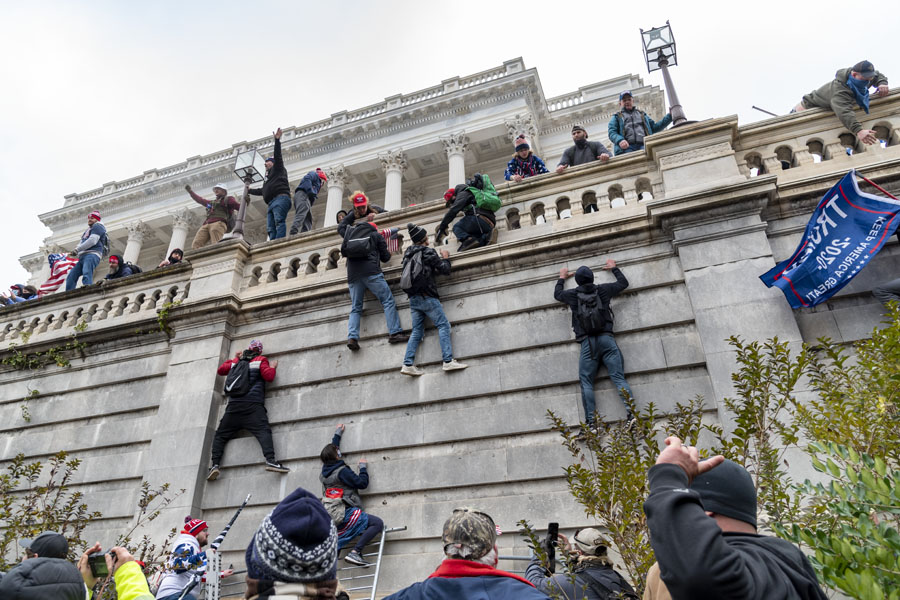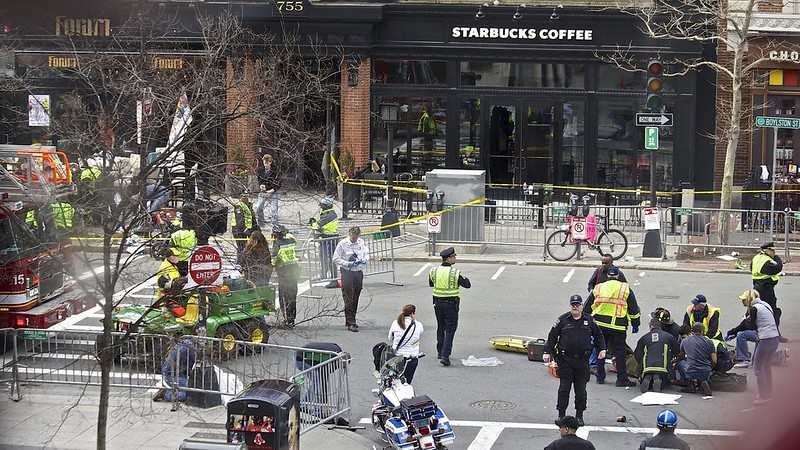Assessing Domestic Violent Extremism One Year After the Capitol Siege
There’s been an ongoing “sea change” in the U.S. government’s domestic counter-extremism policy, but also on domestic violent extremist actors, groups, and movements themselves.

Published by The Lawfare Institute
in Cooperation With

The year after the siege of the United States Capitol on Jan. 6, 2021 has been an understandably momentous one for domestic extremism and counterterrorism in the United States. Just days after the Capitol siege, the Department of Justice and Federal Bureau of Investigation launched a massive effort to investigate and prosecute individuals who breached the Capitol; one year later, more than 700 have been criminally charged in what has become the largest domestic terrorism investigation in the FBI’s history. In June 2021, under the aegis of the first-of-its-kind National Strategy for Countering Domestic Terrorism, a laundry list of federal agencies including the DOJ, FBI, Department of Homeland Security, and Department of Defense issued new counter-extremism guidelines and policies. Finally, in July of last year, the U.S. House Select Committee to Investigate the January 6th Attack on the United States Capitol held its first public hearings, and continued its investigation into the Capitol siege in the following months.
Most post-Jan. 6th commentaries have focused intensely on tracking the status of these investigations, prosecutions, new policies, and Congressional efforts. Fewer have focused on the impacts of the ongoing “sea change” in domestic counter-extremism policy on domestic violent extremist (DVE) actors, groups, and movements themselves. Without a doubt, the recency and frequency of these developments makes precise prognoses difficult. Nevertheless, 2021 was as pivotal for DVE actors as it was for counter-DVE policy, and taking stock of how these actors have fared so far in a post-Capitol Siege environment is vitally important. Although no DVE group—of any ideology—was able to conduct a major terrorist attack since January 6, 2021, DVE movements of multiple persuasions used 2021 as a year to make significant strategic reassessments and changes.
To this end, our recent report for the Program on Extremism on the first anniversary of January 6, 2021 attempts to situate developments in the DVE movements associated with the Capitol siege within the broader changes in the DVE landscape over the past year. We found that the actors and networks that most successfully withstood increased federal law enforcement pressure during the past year were autonomous, decentralized movements with no clear hierarchical leadership structure. In contrast, organized DVE organizations with strict leadership hierarchies and command and control structures faced more severe impacts on their ability to operate in 2021.
This dynamic is illustrated in the respective post-Jan. 6th trajectories of the two extremist groups that federal prosecutors argue were involved to the largest extent in the planning for the Capitol Siege: the Oath Keepers and the Proud Boys. As of Jan. 1, 2022, the Justice Department has publicly charged forty-eight individuals with an alleged nexus to the Proud Boys and twenty-four reported Oath Keepers for breaching the Capitol. The Justice Department argues these two organizations were the most-represented DVE groups at the Capitol Siege, thanks to these organizations’ prior planning and coordination for Jan. 6th. The charging documents from their cases claim that in the weeks and months leading up to Jan. 2021, senior leaders within the Oath Keepers and Proud Boys individually directed their followers to travel to the U.S. Capitol and prepare for violent activities to disrupt the congressional proceeding.
Evidence proving this fact was central to establishing the conspiracy charges that federal prosecutors used to indict the Proud Boys and Oath Keepers networks at the Capitol siege, but it also led to increased federal scrutiny on the groups’ leadership in 2021. The FBI conducted interviews and seized communications devices from Oath Keepers’ founder Stewart Rhodes and the group’s senior counsel Kellye SoRelle. Rhodes, who was also subpoenaed by the House Select Committee in November 2021, is reportedly an unindicted co-conspirator in the case against twenty-one members of the group who allegedly breached the Capitol. Jon Schaffer, a lifetime founding member of the Oath Keepers, was the first Capitol Siege defendant to plead guilty to obstructing Congress in April 2021. The senior leadership of the Proud Boys were also subject to intense legal scrutiny. The group’s leader, Enrique Tarrio, was arrested before the Capitol Siege upon his arrival to Washington, DC on January 4, 2021. Several leaders of local Proud Boys outfits throughout the country—including Ethan Nordean, Joseph Biggs, Zachary Rehl, and Charles Donohoe—were arrested and charged for their alleged role in the Capitol siege.
Despite both groups’ outsized reported role in the Capitol siege and both groups facing significant federal pressure in its wake, the Oath Keepers’ and Proud Boys’ respective capacities for mobilization and operations in 2021 were very different. While the historical patterns of each group play some part in their vastly different 2021 trends, some of these differences can potentially be attributed to organizational structure. The Oath Keepers largely retain a more structured hierarchical arrangement between their central leadership and local groupings. When federal pressure began to target the organization itself and its senior leadership, particularly Rhodes, the group’s ability to mobilize followers towards traditional hotspots (like anti-gun control and other anti-government protests) has seemingly diminished. Sam Jackson notes that historically, Rhodes has tended to avoid playing an explicit role in planning violent or illegal activity when under significant law enforcement pressure. Moreover, rumors that Rhodes and other senior leaders were cooperating with the DOJ Capitol investigation abounded throughout the militia space, harming the organizational credibility of the Oath Keepers. While it may not last, the result was a downturn in Oath Keepers activity in 2021, despite a plethora of flashpoints during protests that may have in the past traditionally witnessed an Oath Keepers presence.
In comparison, organizational decision-making by the Proud Boys is delegated largely to individual chapters, with the national leadership serving largely as figureheads. This autonomy helped specific Proud Boys chapters continue planning violence during 2021, allowing the group to adapt to federal pressure, which was concentrated on national-level leadership and leaders of chapters that were involved in the Capitol siege. Local chapters mobilized, at times violently, during protests across the country involving a variety of issues including COVID-19 mask and vaccine mandates, critical race theory in schools, and election conspiracies. Thus, while post-Jan. 6th pressure from law enforcement was sufficient to shutter some Proud Boys outfits in specific areas, the group continued planning a significant number of violent activities in 2021 due to the resilience of other chapters.
The divergence between the Oath Keepers and Proud Boys after Jan. 6th highlights the effects of “post-organizational” violent extremism, a critical feature of the post-Capitol Siege DVE landscape. In the face of increased federal pressure, strict hierarchies, well-defined leadership charts and roles, and strong command-and-control—typically signs of strength for a domestic terrorist group—are also partially acting as hindrances by allowing federal investigators to “roll up” a DVE organization by targeting its senior officials. Further, as cohesive organizations like the Oath Keepers react to domestic law enforcement scrutiny, it is likely that ideologically-aligned individuals will continue to seek out like-minded actors in the anti-authority Patriot Movement. This is an important consideration as the underlying narratives and grievances continue to radicalize a wide swath of individuals despite the downturn of individual groups such as the Oath Keepers. This trend is also an important one across a range of DVE groups and movements not alleged to have been present in significant numbers at the U.S. Capitol on Jan. 6, including accelerationists like the Boogaloo movement, the neo-fascist skullmask network and a diverse range of domestic actors inspired by a multitude of “mobilizing concepts.”
In light of this, the most lethal domestic violent extremist threats to the U.S., reflected in the Office of the Director of National Intelligence’s March 2021 intelligence assessment, are “lone offenders or small cells of DVEs adhering to a diverse set of violent extremist ideologies” rather than “organizations that allegedly advocate a DVE ideology.” Moving forward, as federal law enforcement continues to exert pressure on the actors, groups, and organizations involved in the Capitol siege, the amorphous nature of the ideologies and movements that they represent will allow certain milieus to sidestep federal scrutiny and others to form.



.jpg?sfvrsn=a9413207_5)
-(1).jpg?sfvrsn=b91ff6a6_7)

